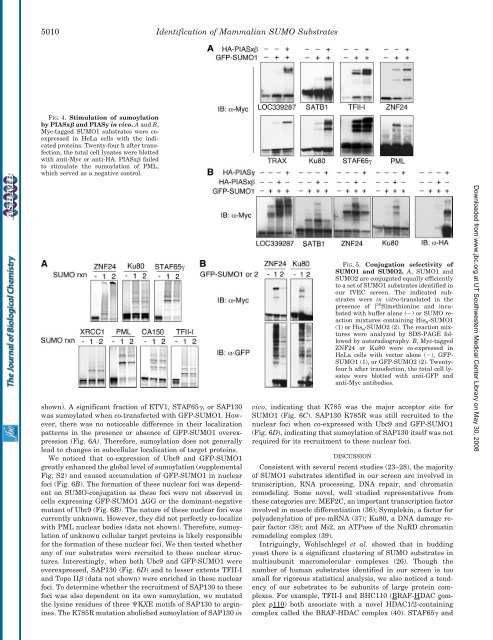Systematic Identification and Analysis of ... - UT Southwestern
Systematic Identification and Analysis of ... - UT Southwestern
Systematic Identification and Analysis of ... - UT Southwestern
Create successful ePaper yourself
Turn your PDF publications into a flip-book with our unique Google optimized e-Paper software.
5010<br />
<strong>Identification</strong> <strong>of</strong> Mammalian SUMO Substrates<br />
FIG. 4. Stimulation <strong>of</strong> sumoylation<br />
by PIASx <strong>and</strong> PIASy in vivo. A <strong>and</strong> B,<br />
Myc-tagged SUMO1 substrates were coexpressed<br />
in HeLa cells with the indicated<br />
proteins. Twenty-four h after transfection,<br />
the total cell lysates were blotted<br />
with anti-Myc or anti-HA. PIASx failed<br />
to stimulate the sumoylation <strong>of</strong> PML,<br />
which served as a negative control.<br />
shown). A significant fraction <strong>of</strong> ETV1, STAF65, or SAP130<br />
was sumoylated when co-transfected with GFP-SUMO1. However,<br />
there was no noticeable difference in their localization<br />
patterns in the presence or absence <strong>of</strong> GFP-SUMO1 overexpression<br />
(Fig. 6A). Therefore, sumoylation does not generally<br />
lead to changes in subcellular localization <strong>of</strong> target proteins.<br />
We noticed that co-expression <strong>of</strong> Ubc9 <strong>and</strong> GFP-SUMO1<br />
greatly enhanced the global level <strong>of</strong> sumoylation (supplemental<br />
Fig. S2) <strong>and</strong> caused accumulation <strong>of</strong> GFP-SUMO1 in nuclear<br />
foci (Fig. 6B). The formation <strong>of</strong> these nuclear foci was dependent<br />
on SUMO-conjugation as these foci were not observed in<br />
cells expressing GFP-SUMO1 GG or the dominant-negative<br />
mutant <strong>of</strong> Ubc9 (Fig. 6B). The nature <strong>of</strong> these nuclear foci was<br />
currently unknown. However, they did not perfectly co-localize<br />
with PML nuclear bodies (data not shown). Therefore, sumoylation<br />
<strong>of</strong> unknown cellular target proteins is likely responsible<br />
for the formation <strong>of</strong> these nuclear foci. We then tested whether<br />
any <strong>of</strong> our substrates were recruited to these nuclear structures.<br />
Interestingly, when both Ubc9 <strong>and</strong> GFP-SUMO1 were<br />
overexpressed, SAP130 (Fig. 6D) <strong>and</strong> to lesser extents TFII-I<br />
<strong>and</strong> Topo II (data not shown) were enriched in these nuclear<br />
foci. To determine whether the recruitment <strong>of</strong> SAP130 to these<br />
foci was also dependent on its own sumoylation, we mutated<br />
the lysine residues <strong>of</strong> three KXE motifs <strong>of</strong> SAP130 to arginines.<br />
The K785R mutation abolished sumoylation <strong>of</strong> SAP130 in<br />
FIG. 5. Conjugation selectivity <strong>of</strong><br />
SUMO1 <strong>and</strong> SUMO2. A, SUMO1 <strong>and</strong><br />
SUMO2 are conjugated equally efficiently<br />
to a set <strong>of</strong> SUMO1 substrates identified in<br />
our IVEC screen. The indicated substrates<br />
were in vitro-translated in the<br />
presence <strong>of</strong> [ 35 S]methionine <strong>and</strong> incubated<br />
with buffer alone () or SUMO reaction<br />
mixtures containing His 6 -SUMO1<br />
(1) or His 6 -SUMO2 (2). The reaction mixtures<br />
were analyzed by SDS-PAGE followed<br />
by autoradiography. B, Myc-tagged<br />
ZNF24 or Ku80 were co-expressed in<br />
HeLa cells with vector alone (), GFP-<br />
SUMO1 (1), or GFP-SUMO2 (2). Twentyfour<br />
h after transfection, the total cell lysates<br />
were blotted with anti-GFP <strong>and</strong><br />
anti-Myc antibodies.<br />
vivo, indicating that K785 was the major acceptor site for<br />
SUMO1 (Fig. 6C). SAP130 K785R was still recruited to the<br />
nuclear foci when co-expressed with Ubc9 <strong>and</strong> GFP-SUMO1<br />
(Fig. 6D), indicating that sumoylation <strong>of</strong> SAP130 itself was not<br />
required for its recruitment to these nuclear foci.<br />
DISCUSSION<br />
Consistent with several recent studies (23–28), the majority<br />
<strong>of</strong> SUMO1 substrates identified in our screen are involved in<br />
transcription, RNA processing, DNA repair, <strong>and</strong> chromatin<br />
remodeling. Some novel, well studied representatives from<br />
these categories are: MEF2C, an important transcription factor<br />
involved in muscle differentiation (36); Symplekin, a factor for<br />
polyadenylation <strong>of</strong> pre-mRNA (37); Ku80, a DNA damage repair<br />
factor (38); <strong>and</strong> Mi2, an ATPase <strong>of</strong> the NuRD chromatin<br />
remodeling complex (39).<br />
Intriguingly, Wohlschlegel et al. showed that in budding<br />
yeast there is a significant clustering <strong>of</strong> SUMO substrates in<br />
multisubunit macromolecular complexes (26). Though the<br />
number <strong>of</strong> human substrates identified in our screen is too<br />
small for rigorous statistical analysis, we also noticed a tendency<br />
<strong>of</strong> our substrates to be subunits <strong>of</strong> large protein complexes.<br />
For example, TFII-I <strong>and</strong> BHC110 (BRAF-HDAC complex<br />
p110) both associate with a novel HDAC1/2-containing<br />
complex called the BRAF-HDAC complex (40). STAF65 <strong>and</strong><br />
Downloaded from www.jbc.org at <strong>UT</strong> <strong>Southwestern</strong> Medical Center Library on May 30, 2008

















